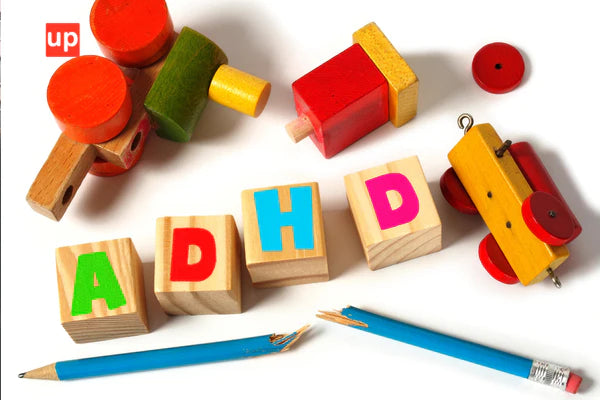
Attention deficit disorder: symptoms and treatment
If you struggle with inattention and its disorders, you may be experiencing attention deficit disorder (ADD). It is characterised by significant difficulties in focusing and completing tasks and can affect all aspects of life. This article lays out a clear path to understanding the symptoms, finding coping mechanisms, and seeking support to effectively manage attention deficit disorder.
Key conclusions
- Attention Deficit Hyperactivity Disorder (ADD) and Attention Deficit Hyperactivity Disorder (ADHD) are similar conditions, with the former characterized by inattention without the hyperactivity and impulsivity that may accompany the latter; it significantly affects cognitive and behavioral functions, affecting executive function, processing speed, working memory, and inhibitory control.
- The aetiology of Attention Deficit Disorder is multifactorial, with genetic influences representing a high degree of heritability and several genes identified as playing a role; environmental factors such as prenatal substances, heavy metals, chemical exposures and exposure to air pollution in early life also contribute to the risk.
- Treatment of Attention Deficit Hyperactivity Disorder involves a combination of behavioural and medication interventions to manage symptoms and improve daily functioning in a variety of settings, such as home and school, supported by comprehensive diagnosis and individualised interventions.
Decoding Attention Deficit Disorder (ADD)

ADD is more than just an attention deficit disorder - it can significantly affect cognitive functions and behaviour, affecting:
- Executive function
- Processing speed
- Working memory
- Inhibitory control
The world through the lens of Attention Deficit Disorder (ADD) can be overwhelming, full of distractions that require attention, making tasks that require constant mental effort challenging. However, with understanding and proper management, individuals with Attention Deficit Disorder can live fulfilling lives, overcoming their unique challenges.
Recognition of Attention Deficit Disorder (ADD)
Attention Deficit Disorder, a subtype of ADHD, manifests itself primarily as challenges with attention and focus. Unlike the hyperactive/impulsive type of ADHD, individuals with attention deficit disorder may not exhibit overtly disruptive behaviors. Key symptoms include:
- Difficulty paying attention to details
- Forgetfulness
- Difficulty concentrating
- Easy distraction
These symptoms can significantly affect a child's behaviour and daily functioning.
The Diagnostic and Statistical Manual (DSM-5), a guide used by healthcare providers, sets out specific criteria for diagnosing inattentive ADHD. These include persistent symptoms of inattention for children up to age 16 or five or more for adolescents 17 and older. For accurate diagnosis and proper treatment, it is essential to recognize and understand these symptoms.
The impact of Attention Deficit Hyperactivity Disorder on everyday life
The invisible nature of Attention Deficit Disorder often masks the profound impact it can have on everyday life. In the workplace, for example, untreated Attention Deficit Disorder can lead to decreased productivity, interpersonal conflicts and high absenteeism due to the individual's difficulty staying focused on their tasks. In addition, the challenges associated with Attention Deficit Disorder can negatively impact an individual's self-image, increase the likelihood of experiencing anxiety and depression, and hinder their ability to take appropriate risks.
On a personal level, individuals with attention deficit disorder may struggle with:
- Staying organized
- Managing distractions
- Balancing work and personal life
- Dealing with an overactive mind
These challenges can in some cases contribute to learning difficulties. Understanding these difficulties is the first step towards seeking help and developing coping strategies.
Origins and risk factors of Attention Deficit Hyperactivity Disorder

Uncovering the origins of Attention Deficit Hyperactivity Disorder is like putting together a complex puzzle, with each piece representing a different element in a person's life. Attention Deficit Disorder has multifaceted origins, with genetic and environmental factors playing a role in its development.
Understanding the interaction between genes and environmental factors is key to understanding the aetiology of the disorder, with the symptoms of Attention Deficit Disorder being linked to interactions between genes and environmental adversities.
Genetic effects
Genes are known to play an integral role in the development of Attention Deficit Disorder. Heritability estimates ranging from 60% to 90% suggest that the condition is largely inherited and familial.
If a parent has attention deficit disorder, the child has a significant chance of inheriting the condition, with a probability of over 50%.
Several genes associated with Attention Deficit Disorder include:
- The serotonin transporter gene (5HTT)
- The dopamine transporter gene (DAT1)
- The dopamine D4 receptor gene
- The LPHN3 gene
- The DRD4 gene
Understanding these genetic bases has contributed significantly to our understanding of ADHD and has paved the way for personalised treatment strategies.
Environmental triggers and ADD
In addition to genetic influences, several environmental factors contribute to the development of Attention Deficit Disorder. These include:
- Prenatal exposure to substances
- Exposure to heavy metals and chemicals
- Exposure to toxic chemicals and chemicals in the environment
- Lifestyle factors
For example, prenatal exposure to toxins, including lead, arsenic, cadmium and environmental cigarette smoke, has been linked to an increased likelihood of developing ADHD.
Diagnosis of Attention Deficit Hyperactivity Disorder
The DSM states that for a diagnosis of Attention Deficit Disorder, individuals must demonstrate behaviors such as regular failure to pay close attention to details or make careless errors in activities, and symptoms of hyperactivity-impulsivity minus inattention in the previous 6 months.
The role of the Diagnostic and Statistical Manual
The most recent update, the DSM-5, defines a persistent pattern of inattention and/or hyperactivity-impulsivity that impairs functioning or development for the diagnosis of Attention Deficit Disorder.
Revisions to DSM-5 include adjustments to each of the diagnostic criteria for Attention Deficit Disorder, a change in terminology for ADHD subtypes, and the incorporation of new definitions. These updates reflect the evolving understanding of ADHD and its subtypes, underscoring the importance of staying current on the latest research in the field.
Collaborative diagnosis
While the DSM provides a critical framework for the diagnosis of Attention Deficit Disorder, a comprehensive diagnosis often requires a collaborative approach. This involves gathering information from multiple sources, including medical examinations, rating scales, and input from parents and teachers.
In particular, parental and teacher input is important in the diagnosis of Attention Deficit Disorder. Electronic systems have the ability to capture information on Attention Deficit Disorder from parents and teachers and their reports have demonstrated moderate to good diagnostic accuracy.
This collaborative approach ensures a more accurate and comprehensive diagnosis, leading to more effective treatment strategies.
Treatment strategies for Attention Deficit Disorder

Once the diagnosis is made, the next step is to develop a treatment plan. This usually involves a combination of behavioural interventions and medication options, tailored to the individual's needs. While treatment can manage symptoms, it should be noted that there is currently no cure for attention deficit disorder.
Thus, the goal of treatment is to help individuals with attention deficit disorder live productive and fulfilling lives.
Behavioural interventions
Behavioural interventions are a cornerstone in the treatment of Attention Deficit Disorder. These interventions include:
- Cognitive and behavioural therapy
- Behavioural training for parents
- Behavioural management in the classroom
- the establishment of specific rules
Cognitive behavioural therapy (CBT), for example, helps manage everyday challenges and can be effective in treating co-occurring anxiety disorders and depression, making it a valuable tool for mental health professionals.
Implementing behaviour management strategies involves:
- Modifying the rewards and consequences provided by parents and teachers
- Improving the daily functioning of individuals by imparting skills to compensate for their symptoms
- Helping to identify environments where they can function at their best.
Medication options
In addition to behavioural interventions, medications can also be effective in treating symptoms These medications, including psychostimulants and non-stimulants, work by increasing the levels of neurotransmitters in the brain. It is important to keep in mind, however, that these medications can have potential side effects, such as:
- decreased appetite
- sleep disturbances
- headaches
- abdominal discomfort
- tachycardia
- increased blood pressure
The length of time for the effects of medication in the treatment of Attention Deficit Disorder to appear can vary, often requiring days to weeks depending on the type of medication. Therefore, during this time, patience and regular communication with healthcare providers are essential to ensure the most effective treatment plan.
While treatment strategies are vital, managing Attention Deficit Disorder also involves adapting to different environments, especially at home and school. At home, a healthy lifestyle, which includes regular exercise, proper nutrition and adequate sleep, is vital.
At school, pupils can find support through understanding and accessing special education services under the Education of People with Disabilities Act.
At home: Promoting a healthy lifestyle
Promoting a healthy lifestyle at home can help improve symptoms of Attention Deficit Disorder and overall well-being. This may include:
- Implementing a daily schedule that includes activities such as yoga
- Review of the calendar
- Following a morning routine
- Organizing the home
Sleep hygiene is another important aspect of managing Attention Deficit Hyperactivity Disorder at home, as well as managing the symptoms that may arise. Ensuring a quiet and comfortable sleep environment, establishing a consistent routine at bedtime and practicing relaxation techniques can all contribute to better quality sleep.
Mindfulness and relaxation techniques, such as mindful meditation, can also help train the brain to focus, reduce hyperactivity and impulsivity, and enhance executive function skills.
At school: Navigating special education services
At school, students with attention deficit disorder can find support through understanding and accessing special education services. These services provide the necessary accommodations and supports for their education, ensuring equal opportunities for academic success. Accommodations may include flexible seating options, extra time for tests, and breaks as needed.
Schools can support students by involving trained specialists, such as clinical psychologists, psychiatrists, to help students devise strategies for completing schoolwork. School counselors also play an important role in supporting students by focusing on specific areas of concern, such as executive functioning, behavior management, academic achievement, social skills, and emotional regulation.
Summary
In this exploration of attention deficit disorder, we shed light on its symptoms, diagnosis, treatment and management strategies. From understanding the role of genetic and environmental factors in the development of Attention Deficit Disorder to navigating the world of special education services, we covered a wide range of topics related to this complex condition.
Frequently asked questions
How can you tell if someone has attention deficit disorder?
What is Attention Deficit Disorder (ADD) versus Attention Deficit Hyperactivity Disorder (ADHD)?
Can you develop attention deficit disorder as an adult?
What does attention deficit disorder do to a person?
What are the symptoms of attention deficit disorder?
Original content from the Upbility writing team. Reproduction of this article, in whole or in part, without credit to the publisher is prohibited.





